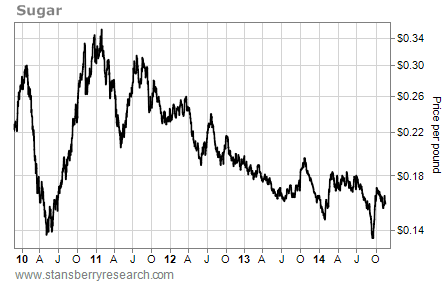 It’s tough to be a commodities investor today…
It’s tough to be a commodities investor today…
Commodities like gold, silver, coal, and uranium have fallen big over the past few years.
But as we’ve told you in Growth Stock Wire before, this sector regularly goes through huge booms and busts.
And the best time to invest in commodities is when they hit “no-brainer” prices.
[ad#Google Adsense 336×280-IA]After the market leaves a natural resource for dead, things often get better.
Production drops… demand picks up… and prices eventually boom.
That’s exactly what’s happening today with sugar…
From 2010 to early 2011, sugar saw a huge boom. Prices surged from less than $0.14 per pound to more than $0.34 – a 142% increase.
Rising prices caused farmers all over the world to increase their sugar production. But this led to an oversupply of the sweet stuff. And sugar entered “bust” mode. Prices are now down 50% from their 2011 highs.

As you can see in the table below, with prices so low, farmers in many countries have scaled back their sugar production.

At first glance, this might not seem like a big deal. Total world sugar production will only decrease 0.06% this year (the season runs from October to September), and some countries are even increasing their sugar production.
But the important thing is the U.S. Department of Agriculture (USDA) believes sugar production in Brazil and Thailand will fall this year.
Jack Scoville, vice president of commodities-focused investment firm PRICE Futures Group, says Brazilian sugar production was down 17% in the second half of October compared to last year.
This is a big deal. Brazil is the goliath of the sugar space. It accounts for 25% of world production. It is also the biggest exporter of sugar. In 2013, Brazil exported 27.7 million metric tons of sugar. Thailand was second, but it only exported a quarter of Brazil’s total. This means there will be less sugar for other countries to import.
As you can see in the table below, world sugar demand is rising – including in the countries that import the most sugar, like the European Union and China.

But Scoville says there is adequate supply in storage to meet this rising demand. So while sugar prices are in the process of putting in a long-term bottom, he doesn’t believe prices will explode higher in the short term.
But that extra sugar won’t last forever. Eventually, the price will move higher.
For starters, the current sugar price is below the cost of production in many countries. According to the Louisiana State University Agriculture Department, it costs about $0.20 per pound to grow sugar there. It costs about $0.21 per pound in Brazil. In other words, at today’s price of $0.16 per pound, growers are losing money.
Meanwhile, major U.S. agribusiness company Bunge Corp. has spent about $3 billion since 2008 to build its sugar-refining business. It hasn’t generated annual operating income since 2009.
The low price is also forcing growers to shut down. Since 2008, out of 430 total sugar mills in Brazil, 50 were shut down and 60 went bankrupt. Reuters recently reported low sugar prices will likely force more mill closures in Brazil.
Low prices force farmers to seek new crops as well. Brazil’s sugar crop is about 8.5% lower this year than last year. It will likely shrink further with the lower prices. So supply is going to continue to dwindle while demand rises.
These are signs of a bottom. And sugar prices have begun to move higher. I expect sugar to rise to $0.18 per pound by the middle of next year. And some estimates say sugar prices will soar to $0.26 per pound by 2022.
Investors looking to speculate on increasing sugar prices can buy one of these three exchange-traded funds with exposure to sugar – the iPath Dow Jones-UBS Sugar Subindex Total Return Fund (SGG), the iPath Pure Beta Sugar (SGAR) Fund, and the Teucrium Sugar Fund (CANE). These funds will do well as sugar prices continue to recover.
Good investing,
Matt Badiali
[ad#stansberry-ps]
Source: Growth Stock Wire
